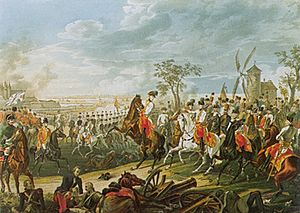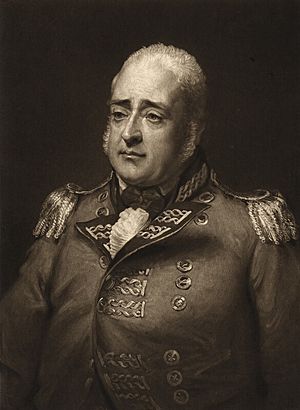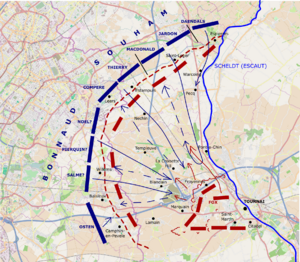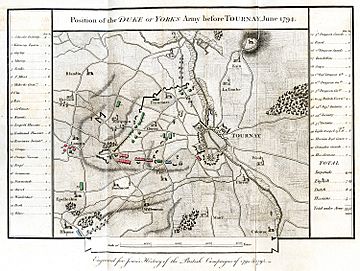Battle of Tournay (1794) facts for kids
Quick facts for kids Battle of Tournay (1794) |
|||||||
|---|---|---|---|---|---|---|---|
| Part of the Flanders campaign in the War of the First Coalition | |||||||
 Austrian command at the Battle of Tournay |
|||||||
|
|||||||
| Belligerents | |||||||
| Commanders and leaders | |||||||
| Strength | |||||||
| 28,000–50,000 | 45,000–62,000 | ||||||
| Casualties and losses | |||||||
| 3,000–4,000 | 6,000, 7 cannons | ||||||
The Battle of Tournay, also known as the Battle of Tournai or Battle of Pont-à-Chin, took place on May 22, 1794. It was a major fight during the Flanders Campaign in modern-day Belgium. French forces, led by General Jean-Charles Pichegru, attacked a group of allied armies. These allies were called the Coalition. They were led by Emperor Francis II and Prince Josias of Saxe-Coburg-Saalfeld.
The Coalition included soldiers from Austria, Great Britain, Hanover, and Hesse-Darmstadt. The battle happened near the city of Tournai, close to the Schelde River. After a long day of intense fighting, the Coalition troops managed to take back important areas, including a place called Pont-à-Chin. This forced the French army to retreat.
In the weeks before this battle, French forces had captured the cities of Courtrai and Menin. The Coalition tried to get these cities back in earlier battles, like the Battle of Courtrai and the Battle of Tourcoing. However, they were not successful. General Pichegru then decided to attack the Coalition directly at Tournai. Even though the French were pushed back, the tough fighting in April and May 1794 made many Coalition leaders think it was too hard to defend the Austrian Netherlands.
Contents
Why did the Battle of Tournay happen?
Who were the armies involved?
In 1794, Lazare Carnot, a key leader in France, planned a new strategy. He wanted the French armies to attack both sides of the Coalition army. This army was defending the Austrian Netherlands. The French planned to capture important cities like Ypres, Ghent, and Brussels on one side. On the other side, they aimed to take Namur and Liège. This would cut off the Austrian army's supply lines. The middle part of the French army would stay on defense.
General Pichegru became the new commander of the French Army of the North. This army had over 126,000 soldiers ready for battle. He also controlled another army, the Army of the Ardennes. Together, his forces totaled more than 227,000 troops. Pichegru organized his left wing near Lille. This wing included several divisions, each with thousands of soldiers.
The Coalition army was led by Prince Coburg. Their forces were spread out.
- On the right side, about 24,000 Austrian, Hanoverian, and Hessian soldiers were near Tournai. They were led by Count Clerfayt.
- In the center, the Prince Frederick, Duke of York and Albany led 22,000 troops near Saint-Amand-les-Eaux.
- Prince Coburg himself was with 43,000 troops near Valenciennes.
- Other parts of the Coalition army were also positioned to defend against French attacks.
What happened before the battle?
The Siege of Landrecies was an early event, where a French fortress surrendered on April 30. On April 24, General Pichegru launched a big attack. His left wing moved towards Nieuport and Ypres. Another French division surrounded Menin. A third division, led by Pichegru himself, captured Courtrai.
In response, Count Clerfayt quickly moved 10,000 troops to Mouscron. But on April 29, the French, with 24,000 men, defeated Clerfayt in the Battle of Mouscron. They captured 3,000 Coalition soldiers and 33 cannons. The Coalition soldiers trapped in Menin managed to escape. This left both Menin and Courtrai in French hands.
The Coalition tried twice to get these cities back. On May 5, the Duke of York arrived at Tournai with 18,000 troops. He joined Clerfayt and other German forces. Meanwhile, Pichegru had added more soldiers, bringing his total to 40,000–50,000 in the area.
On May 10, in the Battle of Courtrai, 23,000 French troops attacked the Duke of York's forces. The French were defeated, mainly by British cavalry. On the same day, Clerfayt attacked Courtrai from the north but failed to capture it. The next day, the French pushed Clerfayt back. Realizing he was outnumbered, the Duke of York asked for more soldiers.
The Battle of Tourcoing happened on May 17–18. The Coalition army, led by Prince Coburg, gathered 74,000 soldiers. They planned a major effort to crush the 82,000 French forces. However, the Coalition suffered a big defeat. This was because of poor teamwork and planning among the Allied leaders. The French, led by General Souham, managed to defeat two main Coalition columns.
The Battle of Tournay
How the armies prepared
After their defeat at Tourcoing, the Coalition army returned to their camps near Tournai on May 19. Emperor Francis and his Austrian generals felt discouraged. The Coalition members blamed each other for what happened. The British soldiers were especially upset with the Austrians for not helping them enough. Despite this, the main Coalition leaders decided to attack again towards Mouscron.
Prince Coburg set up the Coalition army around Tournai. They had an outer line of outposts and an inner circle of defenses. The outer line stretched through villages like Camphin-en-Pévèle and Spiere. The inner line ran through places like Froyennes and Marquain.
General Pichegru arrived the day after Tourcoing. He was given credit for the French victory there. Now, he ordered an attack on the Coalition army at Tournai. Pichegru told General Moreau's division to hold Courtrai and the Lys River line. This would stop Clerfayt from interfering. Other French units were ordered to attack different parts of the Coalition lines. General Souham's division would attack the Coalition's right side near Spiere. General Bonnaud's division would attack the center. Another division would make a show of force on the Coalition's left side.
What happened during the battle?
The battle started early in the morning, between 5:00 and 7:00 am on May 22, 1794. French brigades, led by commanders like General Herman Willem Daendels and General Étienne Macdonald, advanced. Daendels' soldiers attacked the Hanoverians at Spiere and pushed them back. The Hanoverians retreated across the Scheldt River, helped by a British brigade.
Macdonald's troops, supported by others, attacked Pont-à-Chin. This area became the scene of the most intense fighting of the day. Other French attacks on the Coalition center and left were pushed back. The Coalition's left side was commanded by Archduke Charles, Duke of Teschen. The French attack on this side was so weak that the Allies could send troops from there to help other areas.
The French fought very hard, feeling confident after their recent victory at Tourcoing. However, General Pichegru did not give clear orders for the overall battle. An Allied officer said the gunfire was more intense than any old soldier had ever seen. But because both sides fought in spread-out formations, there were fewer casualties than expected.
Macdonald's troops captured Pont-à-Chin four times, but were pushed out each time. Finally, they captured it again. By evening, the French held Pont-à-Chin and other key positions. Prince Coburg ordered that these positions must be taken back, especially Pont-à-Chin. This area was very important because it controlled a main road and river transport. If the French kept it, it would limit the Coalition's movements and threaten their defenses.
At 7:00 pm, the Duke of York sent the British Fox's brigade and seven Austrian battalions to retake Pont-à-Chin. This British brigade had been badly hurt at Tourcoing. As the British infantry attacked, their bravery impressed the nearby Austrian units, who cheered them on. Under this strong attack, Macdonald's French troops panicked and ran away. British cannons quickly set up and fired effectively, stopping the French from regrouping. Fox's brigade captured Pont-à-Chin and a ridge behind it, along with seven French cannons.
General Pichegru and his officers were having dinner near Pont-à-Chin, thinking the position was safe. Suddenly, they heard a warning: "The English, the red-coats!" The French officers quickly ran for their horses, some jumping through windows to escape. The French army then retreated from the battlefield. All fighting stopped by 10:00 pm.
What were the results of the battle?

The Coalition forces lost about 3,000 to 4,000 soldiers. This included those killed, wounded, or missing. The Hanoverians lost 27 killed, 237 wounded, and 154 missing. The British and Austrians lost 1,728 killed and wounded, and 565 missing.
The French suffered more losses. They had about 5,500 to 6,000 soldiers killed or wounded. They also lost 450 men and 7 cannons captured. The British Fox's brigade, despite its small size, fought bravely and lost 120 soldiers. One report even mentioned 280 headless French bodies in an orchard, killed by Austrian artillery.
On May 23, the day after the battle, Karl Mack, Prince Coburg's chief-of-staff, resigned. He believed that taking back the Austrian Netherlands was a lost cause. His replacement also thought it was time to give up on the Austrian Netherlands.
On May 24, Emperor Francis held a meeting with his generals. He painted a grim picture of the situation. Only the Duke of York wanted to attack the French again. That same day, news arrived that the Coalition had won another battle against the French on the Sambre River.
Events in Poland also started to affect Emperor Francis's decisions. A rebellion, called the Kościuszko Uprising, broke out in Poland on March 25, 1794. This surprised the leaders of Austria, Russia, and Prussia. Russia asked Austria for help. Prussia even pulled 20,000 soldiers out of the war against France to deal with Poland.
At the imperial headquarters, some leaders, like Prince Coburg, wanted to continue fighting France. But others, like Waldeck, wanted Austria to focus on Poland. They wanted to stop their rival, Prussia, from gaining too much power there. On May 29, Emperor Francis suddenly left the army and returned to Vienna. This upset his officers and soldiers. Prince Coburg remained in command of the Coalition forces, but he was very reluctant to do so.



